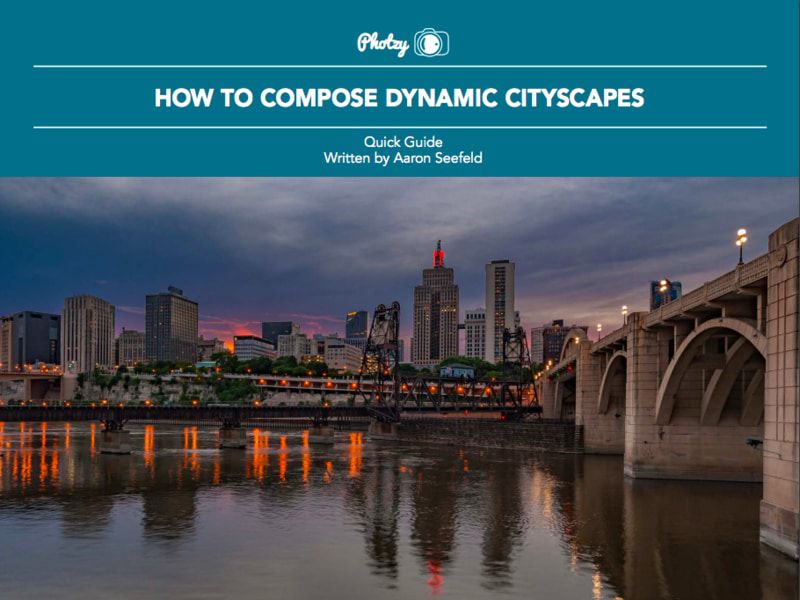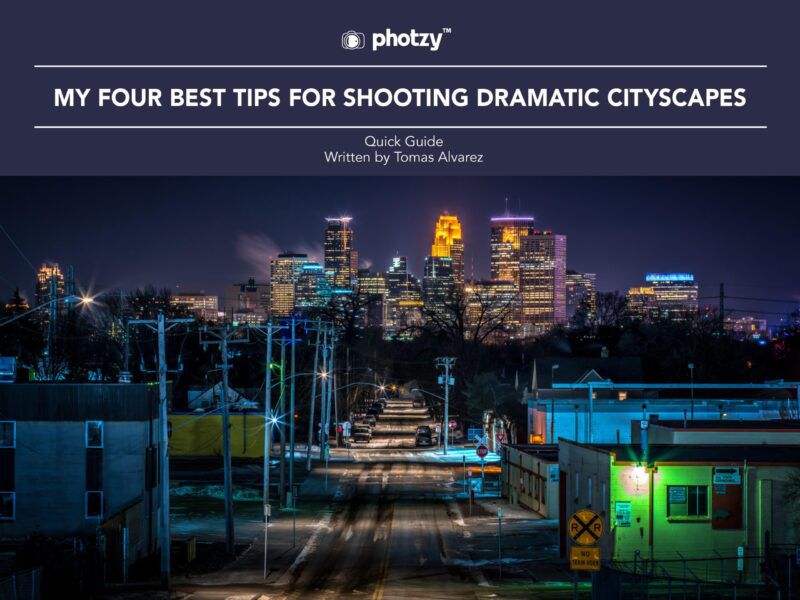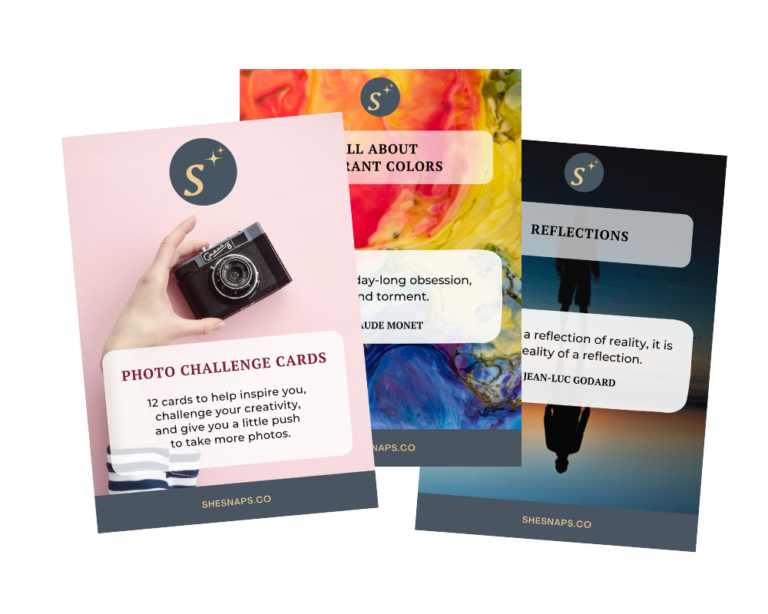Ever gazed at a city skyline and felt the urge to capture its magic? Cities, with their mix of towering buildings, glittering lights and vibrant streets, are a photographer’s playground.
We’ve listed three free guides filled with practical advice and cool techniques, as well as exercises that you can try to practice your cityscape shots. Prepare to immerse yourself in the captivating world of cityscape photography and discover how to make your urban shots truly shine.
1. Quick Guide to Shooting Cityscapes
Key Point: Embrace the Magic of Twilight
Cities come alive with a unique charm as night falls, transforming their concrete and steel structures into radiant beacons of light. One of the most impactful times to capture this transformation is during twilight. Twilight is that magical period when the sun has set, but there’s still enough natural light to illuminate the surroundings. Not only is the light beautifully diffused, but it also enhances the colors and contrasts of cityscapes. To truly capture the essence of a city during this time, it’s crucial to arrive at your chosen location early, allowing ample time to set up your camera and frame the perfect shot. Remember, twilight is fleeting, so every moment counts.
Want to read more? Get the guide here →
Learning Exercises
a) Twilight Timing Challenge
Objective: Capture the essence of the city during the magical twilight hour.
Instructions:
- Choose a location in the city that offers a good vantage point, preferably with a mix of skyscrapers, bridges, or other iconic structures.
- Arrive at least 30 minutes before the expected twilight time to set up your equipment.
- Take a series of photos as the sun sets and twilight begins. Aim to capture the transition of natural light and how it interacts with the city lights.
- Review your photos and note the differences in lighting, color, and contrast as twilight progresses.
- For added challenge, try capturing the same scene on different days and under different weather conditions to observe the variations in the twilight ambiance.
b) Composition Exploration
Objective: Experiment with different compositional techniques to enhance the visual interest of your cityscape images.
Instructions:
- Head to a bustling part of the city with a variety of architectural elements.
- Start by applying the rule of thirds to frame your shots. Place points of interest at the intersections of the grid lines.
- Next, look for leading lines—these could be roads, bridges, or even patterns on buildings. Use these lines to guide the viewer’s eye towards a focal point in your image.
- Play with geometric shapes present in the city environment. Look for triangles, rectangles, and circles, and think about how they can be used to create balance or tension in your composition.
- Review your shots and identify which compositional techniques worked best for different scenes. Reflect on how composition can change the mood or story of a photograph.
2. How to Compose Dynamic Cityscapes
Key Point: Leverage Composition Techniques
Cityscapes offer a plethora of elements that can be used to create compelling compositions. The usual rules, like the Rule of Thirds and the Golden Ratio, can be applied to determine the placement of horizons and subjects. However, it’s essential to be flexible and not strictly adhere to these rules if they compromise the integrity of the scene. Roads, bridges, rivers, and other urban elements can serve as powerful leading lines, guiding the viewer’s eye through the image. Additionally, diagonals and triangles can add depth and interest to your composition. When framing your shots, it’s a good idea to compose a bit more loosely than you might initially think. This approach provides flexibility for post-processing adjustments, such as correcting perspective distortions or experimenting with different crops. Remember, the goal is to capture the essence of the city in a way that’s both visually pleasing and tells a story.
Want to read more? Get the guide here →
Learning Exercises
a) Composition Mastery
Objective: Understand and apply various compositional techniques to cityscape photography.
Instructions:
- Choose a vibrant city location with diverse architectural and natural elements.
- Begin by applying the Rule of Thirds to your shots. Experiment with placing the horizon in both the upper and lower thirds based on the scene’s elements.
- Seek out urban elements like roads, bridges, or rivers and use them as leading lines to guide the viewer’s eye through the image.
- Identify and capture diagonals and triangles within the city environment. Reflect on how these shapes add depth and interest to your composition.
- Review your shots and analyze which compositional techniques added the most visual appeal to your photos. Consider how different techniques can change the story or mood of a cityscape.
b) Panorama Practice
Objective: Capture the expansive beauty of cityscapes through panoramic shots.
Instructions:
- Find a location that offers a wide view of the city, such as a hillside, rooftop, or bridge.
- Turn your camera to portrait orientation.
- Start from one end of the scene and take multiple overlapping shots, ensuring that each shot overlaps by at least 30% with the previous one.
- Use a tripod to ensure stability and consistency in your shots.
- In post-processing, stitch the images together to create a panoramic view of the cityscape. Alternatively, if you used your phone to take a panorama, you may not need to use post-processing to stitch images together if it has a panorama feature.
- Reflect on the challenges and advantages of capturing cityscapes in this format. Consider how the panoramic view changes the viewer’s experience of the city.
3. My Four Best Tips for Shooting Dramatic Cityscapes
Key Point: Seek Uncommon Perspectives for Unique Shots
When capturing cityscapes, it’s easy to fall into the trap of photographing from popular or well-known vantage points. However, to create truly memorable and unique images, it’s essential to seek out uncommon perspectives. Urban exploration can be a fun and rewarding way to discover these hidden gems. For instance, multi-level car parks can offer unexpected views of the city that haven’t been widely captured. Similarly, city parks, bridges, and historical areas can provide fresh angles and compositions. Additionally, using a super-zoom lens can allow for ultra-closeups of buildings, creating a different visual experience by compressing the structures into a 2D plane. Remember, while iconic views have their place, finding a unique perspective can set your work apart and offer a fresh take on familiar scenes.
Want to read more? Get the guide here →
Learning Exercises
a) Urban Exploration Adventure
Objective: Discover and capture uncommon perspectives of the city.
Instructions:
- Spend a day exploring your city with the specific goal of finding unique vantage points. This could include multi-level car parks, alleyways, rooftops, or hidden courtyards.
- Challenge yourself to avoid the most popular or iconic viewpoints.
- Capture at least five images from perspectives or locations you’ve never considered before.
- Reflect on how these new angles change the narrative or feel of the cityscape.
- Compare these shots with more traditional views to appreciate the difference.
b) Compositional Depth Challenge
Objective: Master the art of using foreground, mid-ground, and background to add depth to your cityscape images.
Instructions:
- Choose a location in the city that offers a variety of elements at different distances.
- Frame your shot to include a clear foreground (e.g., a street sign, a car, or a pedestrian), mid-ground (e.g., a street or a park), and background (e.g., skyscrapers or a distant landmark).
- Experiment with different compositional techniques, such as leading lines or the rule of thirds, to guide the viewer’s eye through the image.
- Capture at least three images, each emphasizing a different part of the scene (foreground, mid-ground, or background).
- Review your shots and analyze how the composition affects the viewer’s perception of depth and space in the image.
Further Reading
Starting out in photography can feel like a juggling act with all the gear and learning materials. Want a simpler way to master photography while on the move? Check out Photzy’s Snap Cards Essentials cheat sheets – your go-to guide for on-the-spot training consisting of 20 printable key photography lessons. Discover more about Snap Cards Essentials now.



